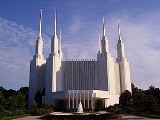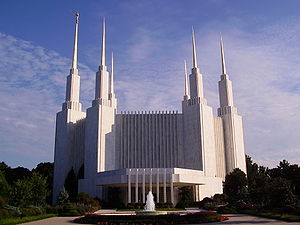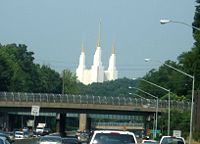
Washington D.C. Temple
Encyclopedia
The Washington D.C. Temple (formerly the Washington Temple) is the 18th constructed and 16th operating temple
of The Church of Jesus Christ of Latter-day Saints. It is located in Kensington, Maryland
, USA, near the Capital Beltway
just north of Washington, D.C.
The temple was dedicated in 1974 after an open house that attracted over 750,000 people including several international dignitaries. The Washington D.C. Temple was the first LDS temple built east of the Mississippi River since 1846, when the original Nauvoo Temple
was dedicated.
Built for about $15 million, the Washington Temple is the tallest U.S. temple; its easternmost spire is 288 feet (87.8 m) tall. Its floor area of 160000 square feet (14,864.5 m²) is the third-largest among U.S. temples. Its design emulates the Salt Lake Temple
with six spires, three on each end, and the building is encased in white Alabama marble. It has a visitors' center. The architecture and highly visible location along the Capital Beltway have made the temple a local landmark in the Washington, D.C. metro area.
The site chosen for the temple was a 57 acres (23.1 ha) wooded hill purchased in 1962 just north of the Capital Beltway
(Interstate 495). Only 11 acres (4.5 ha) of the site was cleared to give the area a more remote feeling. It was the first LDS temple since 1846 in the United States east of the Mississippi River
and remained the only LDS temple in eastern North America until the dedication of the Atlanta Georgia Temple
in 1983.
At the time of the temple's completion, its district included all Latter-day Saint members in 31 U.S. states and the District of Columbia, 7 Canadian provinces, Cuba, Haiti, Puerto Rico, The Bahamas, and the Dominican Republic.
 Original cost estimates for the temple were about $15 million. Members of the church who were within the temple's attendance district were asked to contibute at least $4.5 million dollars. Eventually, local members donated around $6 million for the temple's construction.
Original cost estimates for the temple were about $15 million. Members of the church who were within the temple's attendance district were asked to contibute at least $4.5 million dollars. Eventually, local members donated around $6 million for the temple's construction.
At a completion ceremony the First Presidency buried a metal box with historical items near a corner of the temple. During the first week of the temple open house government officials and diplomats from around the world were taken on special tours through the temple. The open house continued for seven weeks and over 750,000 people went through the temple. The high number of people that attended the open house was due mostly to the large amount of coverage that the temple and Church received as the temple neared completion. Articles were printed in Time, Newsweek, and World Report. There was also a large press conference held that introduced the temple and Spencer W. Kimball
, the Prophet and President of the Church at the time. Demand for tickets to the open house was high and the tickets were gone before the first day of tours and times were extended to accommodate more people. Ten dedicatory sessions were held for the Washington D.C. Temple between November 19 and November 22, 1974. Over 40,000 members were able to attend the dedicatory services.
The tops of four spires on the Temple were knocked off and fell to the ground, as were several pieces of marble from the temple's facade during the 2011 Virginia earthquake
.
, with the three towers to the east representing the Melchizedek Priesthood
leadership, and the three towers to the west representing the Aaronic Priesthood leadership. The temple was designed to be similar in style and form to the Salt Lake Temple so that it would be easily recognized as a temple of The Church of Jesus Christ of Latter-day Saints. The central eastern tower reaches a height of 288 feet (87.8 m), the tallest of any LDS temple. The temple has a total floor area of 160000 square feet (14,864.5 m²), making it the third largest LDS temple. It holds six ordinance rooms and fourteen sealing rooms. The Washington D.C. Temple's angel Moroni statue, which sits atop the tallest tower, is 18 feet (5.5 m) tall and weighs 2 tons. The outer walls are covered in white Alabama marble and the spires are coated in 24-carat gold. There are two large stained glass windows on the eastern and western-most spires. Although there appear to be no other windows, the marble was shaved to 0.625 inches (1.6 cm) thick over window openings, thin enough to be translucent.
 The temple is located in suburban Kensington, Maryland
The temple is located in suburban Kensington, Maryland
, north of Washington, D.C. It is accessible mainly from the Capital Beltway (Interstate 495) exit 33, but also via the Red Line
of the Washington Metro
through a limited free shuttle service to and from the Forest Glen station. The look and white color of the Washington D.C. Temple, coupled with its location near the Capital Beltway has made it a local landmark. D.C.-area traffic reports often refer to the "Mormon temple" or "temple".
In late 1973, an unknown person painted "Surrender Dorothy
" on the girders of a railroad bridge that crosses the Beltway; to drivers approaching the Temple from the east, the words appeared like a caption under the building. The Maryland State Police removed the message, which has been repainted from time to time.
LDS newsletters have cited the graffiti as an example of misconceptions about their religion, although Mormons generally find the re-appearing inscription amusing rather than offensive.
Temple (LDS Church)
In The Church of Jesus Christ of Latter-day Saints , a temple is a building dedicated to be a House of the Lord, and they are considered by Church members to be the most sacred structures on earth. Upon completion, temples are usually open to the public for a short period of time...
of The Church of Jesus Christ of Latter-day Saints. It is located in Kensington, Maryland
Kensington, Maryland
Kensington is a town in Montgomery County, Maryland, United States. The population was 1,873 at the 2000 census. Greater Kensington encompasses the entire 20895 zip code and its population is an order of magnitude larger than that of the town at its center....
, USA, near the Capital Beltway
Interstate 495 (Capital Beltway)
Interstate 495 is a Interstate Highway that surrounds the United States' capital of Washington, D.C., and its inner suburbs in adjacent Maryland and Virginia. I-495 is widely known as the Capital Beltway or simply the Beltway, especially when the context of Washington, D.C., is clear...
just north of Washington, D.C.
Washington, D.C.
Washington, D.C., formally the District of Columbia and commonly referred to as Washington, "the District", or simply D.C., is the capital of the United States. On July 16, 1790, the United States Congress approved the creation of a permanent national capital as permitted by the U.S. Constitution....
The temple was dedicated in 1974 after an open house that attracted over 750,000 people including several international dignitaries. The Washington D.C. Temple was the first LDS temple built east of the Mississippi River since 1846, when the original Nauvoo Temple
Nauvoo Temple
The Nauvoo Temple was the second temple constructed by the Church of Jesus Christ of Latter Day Saints, commonly known as the Mormons. The church's first temple was completed in Kirtland, Ohio, United States in 1836. When the main body of the church was forced out of Nauvoo, Illinois in the...
was dedicated.
Built for about $15 million, the Washington Temple is the tallest U.S. temple; its easternmost spire is 288 feet (87.8 m) tall. Its floor area of 160000 square feet (14,864.5 m²) is the third-largest among U.S. temples. Its design emulates the Salt Lake Temple
Salt Lake Temple
The Salt Lake Temple is the largest and best-known of more than 130 temples of The Church of Jesus Christ of Latter-day Saints. It is the sixth temple built by the church, requiring 40 years to complete, and the fourth operating temple built since the Mormon exodus from Nauvoo,...
with six spires, three on each end, and the building is encased in white Alabama marble. It has a visitors' center. The architecture and highly visible location along the Capital Beltway have made the temple a local landmark in the Washington, D.C. metro area.
History
Plans to build the temple were announced on November 15, 1968; a groundbreaking ceremony was held on December 7. Clearing of the land started May 28, 1971.The site chosen for the temple was a 57 acres (23.1 ha) wooded hill purchased in 1962 just north of the Capital Beltway
Interstate 495 (Capital Beltway)
Interstate 495 is a Interstate Highway that surrounds the United States' capital of Washington, D.C., and its inner suburbs in adjacent Maryland and Virginia. I-495 is widely known as the Capital Beltway or simply the Beltway, especially when the context of Washington, D.C., is clear...
(Interstate 495). Only 11 acres (4.5 ha) of the site was cleared to give the area a more remote feeling. It was the first LDS temple since 1846 in the United States east of the Mississippi River
Mississippi River
The Mississippi River is the largest river system in North America. Flowing entirely in the United States, this river rises in western Minnesota and meanders slowly southwards for to the Mississippi River Delta at the Gulf of Mexico. With its many tributaries, the Mississippi's watershed drains...
and remained the only LDS temple in eastern North America until the dedication of the Atlanta Georgia Temple
Atlanta Georgia Temple
The Atlanta Georgia Temple of The Church of Jesus Christ of Latter-day Saints was the first temple built by the church in the Southeastern United States and the second temple east of the Mississippi River since 1846...
in 1983.
At the time of the temple's completion, its district included all Latter-day Saint members in 31 U.S. states and the District of Columbia, 7 Canadian provinces, Cuba, Haiti, Puerto Rico, The Bahamas, and the Dominican Republic.

At a completion ceremony the First Presidency buried a metal box with historical items near a corner of the temple. During the first week of the temple open house government officials and diplomats from around the world were taken on special tours through the temple. The open house continued for seven weeks and over 750,000 people went through the temple. The high number of people that attended the open house was due mostly to the large amount of coverage that the temple and Church received as the temple neared completion. Articles were printed in Time, Newsweek, and World Report. There was also a large press conference held that introduced the temple and Spencer W. Kimball
Spencer W. Kimball
Spencer Woolley Kimball was the twelfth president of The Church of Jesus Christ of Latter-day Saints from 1973 until his death in 1985.-Ancestry:...
, the Prophet and President of the Church at the time. Demand for tickets to the open house was high and the tickets were gone before the first day of tours and times were extended to accommodate more people. Ten dedicatory sessions were held for the Washington D.C. Temple between November 19 and November 22, 1974. Over 40,000 members were able to attend the dedicatory services.
The tops of four spires on the Temple were knocked off and fell to the ground, as were several pieces of marble from the temple's facade during the 2011 Virginia earthquake
2011 Virginia earthquake
The 2011 Virginia earthquake occurred on August 23, 2011, at 1:51 pm EDT in the Piedmont region of the U.S. state of Virginia. The epicenter, in Louisa County, was northwest of Richmond and south-southwest of the town of Mineral...
.
Architecture
The Washington D.C. Temple was built with a modern six-spire design based on the design of the Salt Lake TempleSalt Lake Temple
The Salt Lake Temple is the largest and best-known of more than 130 temples of The Church of Jesus Christ of Latter-day Saints. It is the sixth temple built by the church, requiring 40 years to complete, and the fourth operating temple built since the Mormon exodus from Nauvoo,...
, with the three towers to the east representing the Melchizedek Priesthood
Melchizedek priesthood
The Melchizedek priesthood is the greater of the two orders of priesthood recognized in Mormonism. The others are the Aaronic priesthood and the rarely recognized Patriarchal priesthood...
leadership, and the three towers to the west representing the Aaronic Priesthood leadership. The temple was designed to be similar in style and form to the Salt Lake Temple so that it would be easily recognized as a temple of The Church of Jesus Christ of Latter-day Saints. The central eastern tower reaches a height of 288 feet (87.8 m), the tallest of any LDS temple. The temple has a total floor area of 160000 square feet (14,864.5 m²), making it the third largest LDS temple. It holds six ordinance rooms and fourteen sealing rooms. The Washington D.C. Temple's angel Moroni statue, which sits atop the tallest tower, is 18 feet (5.5 m) tall and weighs 2 tons. The outer walls are covered in white Alabama marble and the spires are coated in 24-carat gold. There are two large stained glass windows on the eastern and western-most spires. Although there appear to be no other windows, the marble was shaved to 0.625 inches (1.6 cm) thick over window openings, thin enough to be translucent.
Location

Kensington, Maryland
Kensington is a town in Montgomery County, Maryland, United States. The population was 1,873 at the 2000 census. Greater Kensington encompasses the entire 20895 zip code and its population is an order of magnitude larger than that of the town at its center....
, north of Washington, D.C. It is accessible mainly from the Capital Beltway (Interstate 495) exit 33, but also via the Red Line
Red Line (Washington Metro)
The Red Line of the Washington Metro is a rail rapid transit service operating between 27 stations in Montgomery County, Maryland and the District of Columbia, United States. It is a primary line through downtown Washington, and the oldest and busiest line in the system...
of the Washington Metro
Washington Metro
The Washington Metro, commonly called Metro, and unofficially Metrorail, is the rapid transit system in Washington, D.C., United States, and its surrounding suburbs. It is administered by the Washington Metropolitan Area Transit Authority , which also operates Metrobus service under the Metro name...
through a limited free shuttle service to and from the Forest Glen station. The look and white color of the Washington D.C. Temple, coupled with its location near the Capital Beltway has made it a local landmark. D.C.-area traffic reports often refer to the "Mormon temple" or "temple".
In late 1973, an unknown person painted "Surrender Dorothy
Surrender Dorothy
"SURRENDER DOROTHY" is a famous special effect used in the movie The Wizard of Oz, which later attained local fame as a graffito in the Washington, D.C metropolitan area.-Appearance in the movie:...
" on the girders of a railroad bridge that crosses the Beltway; to drivers approaching the Temple from the east, the words appeared like a caption under the building. The Maryland State Police removed the message, which has been repainted from time to time.
LDS newsletters have cited the graffiti as an example of misconceptions about their religion, although Mormons generally find the re-appearing inscription amusing rather than offensive.
See also
- List of temples of The Church of Jesus Christ of Latter-day Saints
- List of temples of The Church of Jesus Christ of Latter-day Saints by geographic region
- Comparison of temples of The Church of Jesus Christ of Latter-day SaintsComparison of temples of The Church of Jesus Christ of Latter-day SaintsBelow is a chronological list of temples of The Church of Jesus Christ of Latter-day Saints with sortable columns. In The Church of Jesus Christ of Latter-day Saints, a temple is a building dedicated to be a House of the Lord, and considered by church members to be the most sacred structures on earth...
- Temple architecture (Latter-day Saints)

